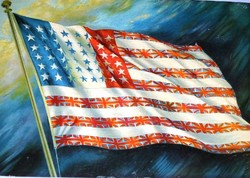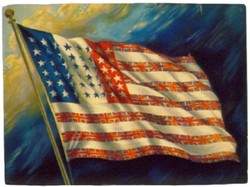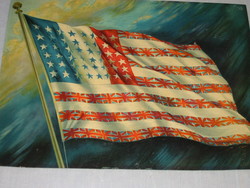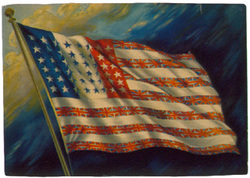

Horizontal- painting edit

Book Photo - edit

Horizontal Painting

Book Photo
Oil Painting the "Humanity Flag", 1917.
Sub-collection: Mastai - Early American FlagsThe Humanity flag oil painting; The Franco-Anglo-American Alliance.
An oil-painting of a flag contemporary to America's entry into World War I, depicting the US as beacon and protector of freedom and democracy.
Painted-on-cloth a rendition of a Franco-Anglo-American flag (ZFC0641) commonly called "The Humanity Flag" circa 1918. Outside dimensions 16 x 19.5". Acquired in Oct 2002 at Sotheby's Auction of the Mastai Collection; an original painting of the "Humanity Flag" ZFC0740.
The Humanity Flag, a special novelty variant of the 48-star US flag was patented (#51812) by Albert Hewitt of Mount Vernon, NY, on February 26th, 1918. In his alliance flag, Hewitt substituted the rows of the British jack for the red stripes of the Stars & Stripes. The canton, instead of being all blue, was divided vertically into the French tri-color-blue, white, and red; and the forty-eight stars upon that canton are shown in colors opposite of the tri-colors bars.
It was his belief that this flag, which was marketed as a painting, a lithograph as well as an actual cloth flag, was a graphic representation of Woodrow Wilson's famous justification for the US entering World War I; to make the world safe for democracy. Delivered on April 2, 1917, in a speech before a joint session of Congress, Wilson clearly detailed that the intentions of the United States was not to defeat Imperial Germany.
This was formerly part of the acclaimed collection of noted antique dealer Mr. Boleslaw Mastai and his wife Marie-Louise d'Otrange Mastai, formerly of New York City, and later Amagansett, Long Island. Their collection was the result of fifty years of collecting, research and study by the late husband-wife team. Mastai, started collecting in the early 20th century and amassed to greatest private flag collection in the United States which he detailed in his landmark book The Stars and The Stripes; The American Flag from Birth of the Republic to the Present, published by Alfred Knopf, New York 1973, and hailed as a revelation of the American Flag as art and as social history.
Accompanying all of the Humanity flags were labels which read:
The Humanity Flag "Auxilio Dei"
This Flag will make the World safe for Democracy and Humanity
Manufactured exclusively by The Commercial Decalcomania Co. Inc.
Sole Distributor: Muirheid-Winter Co. Inc.
200 Fifth Avenue, New York City.
"It is a noble consummation that at the conclusion of a hundred years of unbroken peace among the United States, Great Britain and France. These three once-warring Powers should be firmly united in an alliance for waging the world's latest and greatest conflict, for what we may hope will be the final vindication of the great principles which first brought them together, in so different circumstances, at Yorktown. It is an appropriate commemoration of their century of peace."
Exhibition History:
First Presidio Exhibit
(ZFC0641 and ZFC0642)
Franco-Anglo-American Alliance 48-Star Flag And Illustration: The Humanity Flag
Exhibited in The American Flag, I and II
Second Presidio Exhibit, 2003 - GALLERY VI
(ZFC0641 and ZFC0642)
48-Star Flag and Illustration Franco-Anglo-American Alliance "Humanity Flag"
Publication History:
Madaus, Howard M., Dr. Whitney Smith, The American Flag: Two Centuries of Concord and Conflict. Santa Cruz: VZ Publications, 2006, p. 120.
Depicted in The American Flag, p. 121.
Ostermann, Flak, French security and Defense Under Sarkozy and Chirac, Zutphen, CPI - Wöhrmann Print Service B.V., 2015.Pp.376. Cover art.
Provenance: Acquired by the Zaricor Flag Collection (ZFC0641 and ZFC0642) in 2002 from the Mastai Flag Collection of New York City through auction at South Bay Auction of New York City.
ZFC Significant Flag
Item is Framed
Sources:
Madaus, Howard M.- Whitney Smith, The American Flag: Two Centuries of Concord and Conflict, VZ Publications, Santa Cruz, 2006.
Mastai, Boleslaw and Marie-Louise D'Otrange, The Stars and The Stripes: The American Flag as Art and as History from the Birth of the republic to the Present, Knopf, New York, 1973.
Thomas Woodrow Wilson, Wikipedia, 8 November 2011, from:
http://en.wikipedia.org/wiki/Woodrow_Wilson
Jean Adrien Antoine Jules Jusserand, Wikipedia, 8 November 2011, from: http://en.wikipedia.org/wiki/Jean_Jules_Jusserand
Casus belli, Wikipedia, 8 November 2011, from:
http://en.wikipedia.org/wiki/Casus_belli
Image Credits:
Zaricor Flag Collection
Stars | |
|---|---|
| Comments on Star Measurements | 48 stars in a painting |
Frame | |
|---|---|
| Is it framed? | yes |
| Frame Height | 16 |
| Frame Length | 19.5 |
Stars | |
|---|---|
| Number of Stars | 48 |
| Are there stars on obverse? | no |
| Are there stars on reverse? | no |
Stripes | |
|---|---|
| Has a Blood Stripe? | no |
Nationality | |
|---|---|
| Nation Represented | United States |
Fabric | |
|---|---|
| Fabric | Cotton |
| Comments on Fabric | Illustration printed on paper. |
Documentation | |
|---|---|
| Documents |
All original documents and drawings are held in the Zaricor Flag Collection Archives.
|
| Drawings |
All original documents and drawings are held in the Zaricor Flag Collection Archives.
|
Condition | |
|---|---|
| Condition | Fair |
| Displayable | yes |
Date | |
|---|---|
| Date | 1917 |
Exhibits | |
|---|---|
| Exhibition Copy | First Presidio Exhibit (ZFC0641 and ZFC0642) Franco-Anglo-American Alliance 48-Star Flag And Illustration: The Humanity Flag Date: 1918 Media: Printed on cotton; illustration printed on paper Comment: In 1917, the United States entered World War I on the side of the beleaguered Allied Powers: the failing Russian regime, England, and France. To reflect the alliance between the United States, England, and France on the "Western Front", Albert Hewitt of Mount Vernon, NY., patented this special variation of the United States "Stars & Stripes" on February 26th, 1918. In his "alliance flag", Hewitt substituted rows of the British "jack" for the red stripes of the "Stars & Stripes". The canton, instead of being all blue, he divided vertically into the French tri-color-blue, white, and red. And the forty-eight stars upon that canton are shown in colors opposite of the tri-color's bars. Provenance: Acquired by the Zaricor Flag Collection (ZFC0641 and ZFC0642) in 2002 from the Mastai Flag Collection of New York City through auction at South Bay Auction of New York City. Second Presidio Exhibit, 2003 - GALLERY VI (ZFC0641 and ZFC0642) 48-Star Flag and Illustration Franco-Anglo-American Alliance "Humanity Flag" Date: 1918 Media: Printed cotton flag; printed illustration on paper Comment: In 1917 the United States entered World War I on the side of the beleaguered Allied Powers-a failing Russian regime, Britain, and France. To reflect the new alliance between the Americans, British, and French on the Western Front, Albert Hewitt of Mount Vernon, New York, patented this special variation of the United States' Stars and Stripes on February 26, 1918. In his "alliance flag," Hewitt substituted rows of the British Union Jacks for the red stripes of the American flag. The canton, instead of being all blue, was divided vertically into the French Tricolor of blue, white, and red. The 48 stars on that canton are shown in colors contrasting to the Tricolor's bars. Hewitt dubbed his design "the Humanity Flag" because, as he explained, "This flag will make the world safe for Democracy and Humanity." Provenance: Acquired by the Zaricor Flag Collection (ZFC0641 and ZFC0642) in 2002 from the Mastai Flag Collection through auction at South Bay Auction of New York City. |
Publications | |
|---|---|
| Publication Copy | Madaus, Howard M., Dr, Whitney Smith, The American Flag: Two Centuries of Concord and Conflict. Santa Cruz: VZ Publications, 2006, p. 120. "48-Star Flag Franco-Anglo-American Alliance "Humanity Flag" Oil Painting In 1917 the United States entered World War I on the side of the beleaguered Allied Powers-a failing Russian regime, Britain, and France. To reflect the new alliance between the Americans, British, and French on the Western Front, Albert Hewitt of Mount Vernon, New York, patented this special variation of the United States' Stars & Stripes on February 26, 1918. In his "alliance flag," Hewitt substituted rows of British Union flags for the red stripes of the American flag. The canton, instead of being all blue, was divided vertically into the French Tricolor of blue, white, and red. The 48 stars on that canton are shown in colors contrasting to the Tricolor's bars. Hewitt dubbed his design "the Humanity Flag" because, as he explained, "This flag will make the world safe for Democracy and Humanity." Date: 1918 Size: 16" high x 19.5" wide Medium: Oil painting Provenance: Acquired by the Zaricor Flag Collection in 2002 from the Mastai Flag Collection through auction at South Bay Auction of New York City. ZFC0642" |
| Publication Images | |





